
The Portuguese escudo was the currency of Portugal from 22 May 1911 until the introduction of the euro on 1 January 2002. The escudo was subdivided into 100 centavos. The word escudo literally means shield; like other coins with similar names, it depicts the coat of arms of the state.

The Macanese pataca or Macau pataca is the currency of Macau. It is subdivided into 100 avos, with 10 avos called ho (毫) in Cantonese.

Postage stamps and postal history of the Azores surveys the postal history of the Portuguese archipelago, situated in the north Atlantic.

The rupia was the currency of Portuguese India sometime after 1668 until 1958. Prior to 1668, the currency unit was Xerafim. In 1666, the Portuguese administration struck a silver coin calling it double xerafin and this was declared equal to a rupia in circulation in India outside of Portuguese possessions. A xerafim was a convertible subunit of rupia, and it was unique to Portuguese colonies in India. One rupia equalled two xerafims.
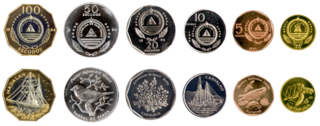
The escudo is the currency of the Republic of Cape Verde. One escudo is subdivided into one hundred centavos.

The Brazilian currency has been renamed and redefined several times through its history. Since 1994, the official one is the Brazilian real (plural reais, with symbol R$ and ISO code BRL.

The real was the unit of currency of Portugal and the Portuguese Empire from around 1430 until 1911. It replaced the dinheiro at the rate of 1 real = 840 dinheiros and was itself replaced by the escudo at a rate of 1 escudo = 1000 réis. The escudo was further replaced by the euro at a rate of 1 euro = 200.482 escudos in 2002.

The escudo was the currency of São Tomé and Príncipe between 1914 and 1977. It was equivalent to the Portuguese escudo and subdivided into 100 centavos.

The escudo was the currency of Angola between 1914 and 1928 and again between 1958 and 1977. It was subdivided into 100 centavos with the macuta worth 5 centavos and was equivalent to the Portuguese escudo.
The angolar was the currency of Portuguese Angola between 1928 and 1958. It was subdivided into 100 centavos or 20 macutas. Angolar is Portuguese for "of Angola".
The real was the currency of Portuguese Cape Verde until 1914. It was equal to the Portuguese real. Portuguese coins were used but banknotes were issued by the Banco Nacional Ultramarino specifically for Cape Verde starting in 1865. The real was replaced by the Cape Verdean escudo, at a rate of 1000 réis = 1 escudo.
The real was the currency of Portuguese São Tomé and Príncipe until 1914. It was equivalent to the Portuguese real. Coins were issued specifically for São Tomé and Príncipe until 1825 and banknotes were issued for the colony beginning in 1897. The real was replaced by the escudo at a rate of 1000 réis = 1 escudo.
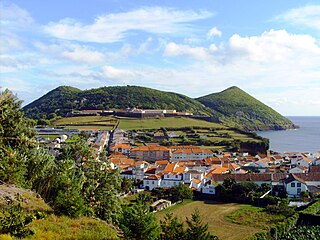
The Fortress of São João Baptista, also known as the Fort of São Filipe or Fort of Monte Brasil is a historic fortress and defensive emplacement, located in the civil parish of Sé, municipality of Angra do Heroísmo in the Portuguese island of Terceira, archipelago of the Azores.
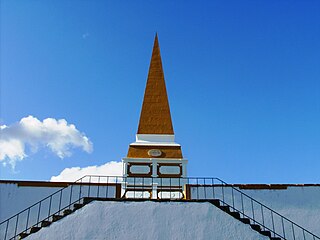
The Castle of Moinhos, officially known as the Castle of São Cristóvão, or Castle/Fort of São Luís is the name of the ruins of 16th-century fortification in city of Angra, on the Portuguese island of Terceira in the archipelago of the Azores. It is primarily known as the Castle of Moinhos, owing to the popular name given to the site for the number of mills that dotted the hilltop, on which the castle was erected.

The Fort of Negrito is a 16th-century maritime fort situated in the civil parish of São Mateus da Calheta, in the municipality of Angra do Heroísmo on the island of Terceira, Azores, Portugal.
José Guilherme Reis LeiteGC IH, is a professor, historian and Azorean politician, whose functions included his role as Regional Secretary for Education and Culture, deputy and President of the Legislative Assembly of the Azores, in addition to representative for the Azores in the Portuguese National Assembly.

D. Antão de Almada, 12th Count of Avranches, 9th Lord of Pombalinho and 14th Majorat of Lagares d'El-Rei was the Grand Master of Ceremonies for the Royal House and, owing to his positions, made administrator of a few Portuguese colonies, including the first Captain-General of the Azores.
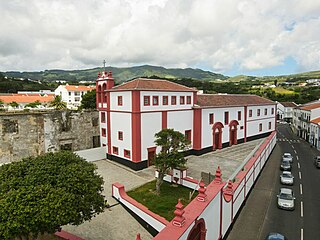
The Convent of Nossa Senhora da Conceição is a former convent situated in the civil parish of Sé, in the historic centre of the municipality of Angra do Heroísmo, in the Portuguese archipelago of the Azores.
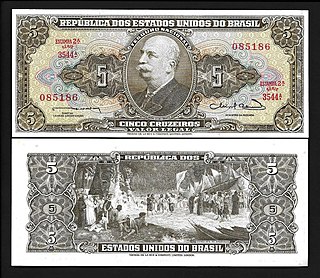
The (first) cruzeiro was the official currency of Brazil from 1942 to 1967. It replaced the old real, which had been in use since colonial times, at the rate of Rs 1$000 = Cr$1, It was in turn replaced by the cruzeiro novo, at the rate of Cr$1,000 = NCr$1.

The cruzeiro, initially denominated cruzeiro novo, was the currency of Brazil between 1967 and 1986. It is the second of the 3 historical Brazilian currencies called "cruzeiro".

















